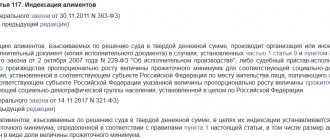Obligation to withhold alimony
Alimony relations are regulated by Section V of the Family Code of the Russian Federation.
An employing organization (or an individual entrepreneur) can transfer alimony for an employee both by obligation on the basis of executive documents (Article 109 of the RF IC) and by a voluntary decision of the employee himself.
In the first case, we are talking about the fact that one of the following types of enforcement documents must initially be sent to the company by the bailiff or the recipient of alimony:
- writ of execution (most often);
- court order;
- a notarized agreement on the payment of alimony (this agreement is concluded voluntarily between the recipient of alimony and the person who undertakes to pay it, without participation in court.
The executive document received by the employer is valid only if it is an original.
The only exception is the agreement on the payment of alimony - it can be in the form of a copy, but it must be certified by a notary. Also, receiving a copy of the writ of execution in the form of an attachment takes place in the case when a bailiff’s order is received to foreclose on the debtor’s wages (Part 3 of Article 98 of Federal Law No. 229-FZ of October 2, 2007). In other situations, if an organization has received a copy of the writ of execution, then it has the right to return it to the sender or not to respond to such a document at all. Having received an official document-foundation, from that time on the company has an obligation to withhold alimony from the employee’s income (Part 3 of Article 98 of Law No. 229-FZ).
If an employee voluntarily, without any legal grounds, wants to transfer alimony through his employer, then no obligations arise for the organization. For an accountant, this is an additional burden and therefore he has the right to decide whether to accept the employee’s request or refuse him. If the organization agrees to withhold alimony, then the employee must provide a written statement of withholding.
Suspension of enforcement proceedings on alimony
At any time, a person who is obliged, according to the court, to pay regular sums of money to the collector, can send an application to the judicial authorities or bailiffs for a temporary suspension of enforcement proceedings. But in order to stop production, compelling reasons are required.
Reasons due to which production may be stopped include:
- Deterioration of the debtor's health;
- Appealing a writ of execution;
- Search for the defaulter.
The procedure for stopping alimony payments will only be in effect until all the reasons that led to the suspension of proceedings are eliminated. Otherwise, bailiffs do not have the right to collect debt from the debtor.
Maximum retention percentage
It should be noted that deductions from the employee’s income for various reasons, including alimony, must be made from the amount remaining after the deduction of personal income tax. This is indicated in Part 1 of Art. 99 of Federal Law 229-FZ.
In Part 3 of Art. 138 of the Labor Code of the Russian Federation, as well as in Part 3 of Art. 99 of Law 229-FZ establishes the maximum amount that can be withheld from a child support provider - this is 70% of income (minus personal income tax) for minor children.
But what if an employee has deductions under several executive documents?
Let's look at an example. The employee has a writ of execution to withhold alimony in the amount of 25% (1/4) of wages, and the employer has also received another writ of execution - to collect property tax debt in the amount of 30% of wages up to a limit of 30,542.38 rub. The monthly salary of the debtor employee is 50,000 rubles.
In this case, the accountant must take into account the order in which the claims of the creditors are repaid. According to Part 1 of Art. 111 of Law No. 229-FZ of October 02, 2007, alimony is the first priority of execution, and mandatory payments to the budget (property tax) are the third priority. Moreover, when distributing the amounts to be collected, it is necessary to first satisfy the first priority in full and only then pay off the next ones (Part 2 of Article 111 of Law No. 229-FZ of October 2, 2007).
As a result, the amount of alimony includes the limit established by law of 70%, so we withhold it in full:
Amount of alimony = (50,000 - 13%) * 25% = 10,875.00 rubles;
Next, we calculate the maximum amount that can be withheld under several enforcement documents - this is 50% of earnings (Part 2 of Article 99 of Law 229-FZ of October 2, 2007 and Part 2 of Article 138 of the Labor Code of the Russian Federation):
Maximum deduction for two writs of execution = (50,000 - 13%) * 50% = 21,750 rubles.
Amount of withholding under the second writ of execution = (50,000 - 13%) * 30% = 13,050 rubles. It will no longer be possible to withhold this amount in full; accordingly, the remaining amount after payment of alimony must be sent to pay off the tax penalty under the second writ of execution: 21,750 - 10,875 = 10,875 rubles. This order must be followed until the deductions (or one of the deductions) are fully made.
Resumption of enforcement proceedings on alimony
The bailiffs and the judge have the right to resume the procedure for paying alimony. The grounds that led to the resumption of the procedure are the elimination of all circumstances stopping the collection of funds. It is important to remember that it is possible to demand collection of debts even if the judge has not yet made a decision, but all the circumstances in the civil case have been completed.
In order for the bailiffs to resume collecting money from the husband in favor of the child, a special application is required. Only the claimant has the right to make this statement. The form is issued by the relevant branch of the government agency. It is interesting that instead of the claimant, his legal representative (for example, a lawyer who helped in court) has the right to send an application. In this case, the legal representative is required to attach a notarized power of attorney that he has the right to act on behalf of the applicant.
What employee income should be taken into account when deducting
A list of all employee income from which alimony for minor children must be withheld is given in Decree of the Government of the Russian Federation No. 841 of July 18, 1996. The same list is also valid for adult children (according to letter of the Ministry of Labor of the Russian Federation dated September 12, 2017 No. 11-1/OOG-1816).
For example, deductions must be made from all types of employee wages, additional remuneration, bonuses, vacation pay, allowances, payments based on average earnings (that is, vacation pay, compensation for unused vacation days, business trips), sick leave at the expense of the employer, financial assistance that is paid not at the expense of budgets and extra-budgetary funds, compensation upon dismissal, etc.
Income in this case can be both in cash and in kind, and from all places of work - both from the main place and part-time (clause 1 of Resolution No. 841 of July 18, 1996).
But it is also important to take into account another list - it reflects income from which alimony cannot be withheld. This list is given in Art. 101 of Law No. 229-FZ of October 2, 2007.
For example, alimony cannot be collected from benefits at the expense of the Social Insurance Fund (children's benefits, payment of days on sick leave at the expense of the Social Insurance Fund), from reimbursable expenses incurred by the employee during a business trip (payment for travel, food, etc.), from compensation for the cost of travel to the place treatment and back, etc.
How to transfer alimony
The accountant must withhold alimony from the moment he receives the writ of execution. This is enshrined in Part 3 of Art. 98 of Law No. 229-FZ of October 2, 2007. It may also indicate a specific date from which deductions must begin.
But it is important to know that if the organization received the writ of execution later (09/30/2019) than the start date of withholding established in it (from 08/15/2019), then collections still need to be made from the date of receipt of the writ of execution.
Alimony must be transferred within three working days from the date of transfer of income to the alimony employee.
This is indicated in Part 3 of Art. 98 of Law 229-FZ of October 2, 2007, as well as in Art. 109 RF IC. The same legal acts state that the costs of transferring alimony to the recipient are at the expense of the alimony provider. That is, for example, the bank’s commission for transferring funds can also be safely withheld from the debtor’s income. All bank details of the alimony recipient are indicated in the writ of execution or annexes to it. The payment order must indicate the order “1”. And in the purpose of payment, it is necessary to include a link to the writ of execution and the period for which payment is made, for example: “Deduction for enforcement proceedings No. 3437/19/37003-IP dated January 23, 2019 in the amount of 1,715.75 rubles. for August 2021 for Irina Ivanovna Ivanova.”
If there are no details, then the organization will have to send money by postal order to the recipient's address.
All ways to pay off debt to the FSSP
There are different ways to pay off accumulated debt. There are practically no restrictions here. Payment can be made remotely using online services, at terminals and ATMs, at the cash desks of most Russian banks, as well as during a personal visit to the territorial branch of the FSSP.
Note! Depending on the chosen method, there may be a commission, and its size, which is added to the repayment amount, may differ.
Most often, commission fees are present when paying through third-party resources, either from electronic wallets, or in bank-to-bank transactions. Payment deadlines may also vary. With some methods, funds are credited instantly, with others, it can take up to 5 days for money to pass between accounts.
There are several popular ways to pay off your FSSP debt. Here it should be taken into account that in most of them there will be a commission, and the period for receipt of money into the department’s account may take longer. Therefore, it is better to pay in advance. Here are the main debt repayment options:
- Sberbank Online. This option is available to clients of this bank. You will have to fill out a short form in the service and indicate all the recipient’s information. For information about payment details, see the notice received from the bailiffs.
- Electronic wallets. In this case, you will also need to use all payment details from the receipt. Plus, there is always a commission. Its size differs in different resources.
- By receipt at the bank's cash desk. A convenient method, but if you choose a bank for payment, it is better that it is the same one where the FSSP current account is located. You will find such information in the notification you receive.
- Payment terminals. This method allows you to deposit cash into the device. To pay, you must select the “Other services” block and fill in all the required data.
- FSSP services. This option is the most reliable, payment arrives quickly enough, and there are no commissions.
Storage and validity periods of executive documents
When receiving a document justifying the collection of alimony, the organization is recommended to send the claimant a notification that the organization received the document on such and such a date and accepted for execution.
However, according to the law there is no such obligation. Such executive documents must be stored as strict reporting forms for five years. They are subject to execution throughout the entire period of their validity, as well as for another three years after the end of this period - as noted in Part 4 of Art. 21 of Law No. 229-FZ.
For the loss or failure to produce executive documents on the part of the employer, fines are imposed (Part 3 of Article 17.14 of the Code of Administrative Offenses of the Russian Federation):
- for an official individual - 2500 rubles;
- for the chief accountant or manager - 15,000 - 20,000 rubles;
- for organization - 50,000 - 100,000 rubles.
It is better to assign the responsibility for the safety of writs of execution to a competent official by appropriate order.
Amount and form of alimony
The form of payment is determined by the claimant and established by the court. There are three types:
| Share | For one child 25% is paid, for two – 33%, for three or more – 50% |
| Fixed size | It is established according to PM in the region when it is not possible to clarify the exact amount of the payer’s earnings, in the absence of employment or receiving a salary in foreign currency (Article 83 of the RF IC) |
| Mixed | Combines the two forms above. Relevant if the person obligated for alimony has both a stable and “floating” income |
When collecting alimony as a share of the salary, the amount depends on the payer’s earnings and the number of children.
If alimony is collected in a fixed sum of money (TDS), the cost of living and the financial situation of both parties are taken into account.
The above is only relevant when claiming through court. When establishing alimony obligations by agreement, the parties independently determine the form, amount and procedure for payment.
Termination of execution
If an employee resigns, the organization is obliged to notify the bailiff about this within three days from the date of dismissal; the notification must also indicate information about the debtor’s new place of work (if known) - Part 1 of Art.
111 IC RF. In addition, if an employee is fired or alimony has already been withheld in full, as well as in other cases, then in accordance with Part 4.1 of Art. 98 of Law No. 229-FZ of October 2, 2007, the employer must return the writ of execution to the bailiff (collector) no later than the next day after completion of the execution of the collection of alimony.
In this case, a mark is placed on the document itself indicating the reason for the end of its execution, the collection period and the amount of the collected amount. Such a mark is certified by the signature of an authorized official and the seal of the organization. The original writ of execution should be sent along with a covering letter. Before returning the document to the bailiff (collector), the accountant is recommended to make a copy of it in case of any controversial issues.
Unlock access to the private part of Clerk with a Premium subscription. Get hundreds of webinars and online courses, unlimited consultations and other proprietary content for accountants.
Hurry up to subscribe with a 20% discount until October 15, 2021. Read more about “Premium” here.
What debts are transferred to the FSSP for processing by bailiffs?
Forced collection is initiated by individuals, government agencies, or organizations. The appearance of debts is preceded by a trial and the issuance of a court order. Most often, such a procedure is initiated for the following reasons:
- You took out a loan or microloan and did not pay it on time, accumulating a decent amount of debt.
- Non-payment of alimony.
- Existing utility debts, with penalties and fines accrued on them.
- Availability of promissory notes when borrowing money from an individual.
- Various fines, primarily from the traffic police.
- Rental debts and other financial obligations that you have not met.
It turns out that any person who is interested in the return of funds can act as a plaintiff. Do not ignore notifications sent to your mailing address from the Federal Bailiff Service.




